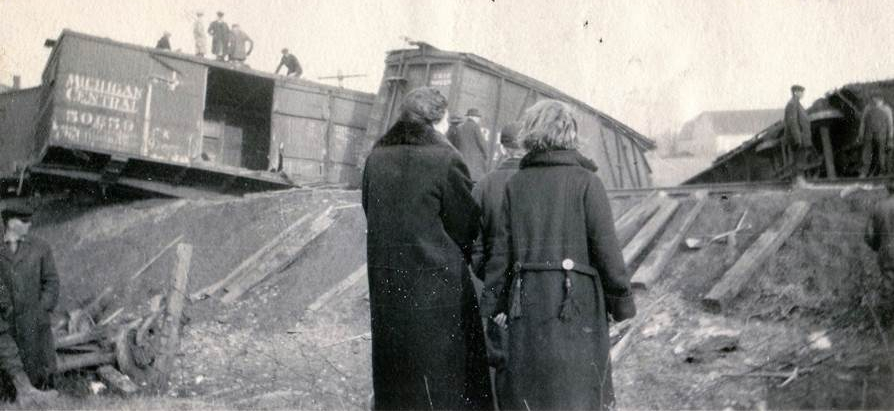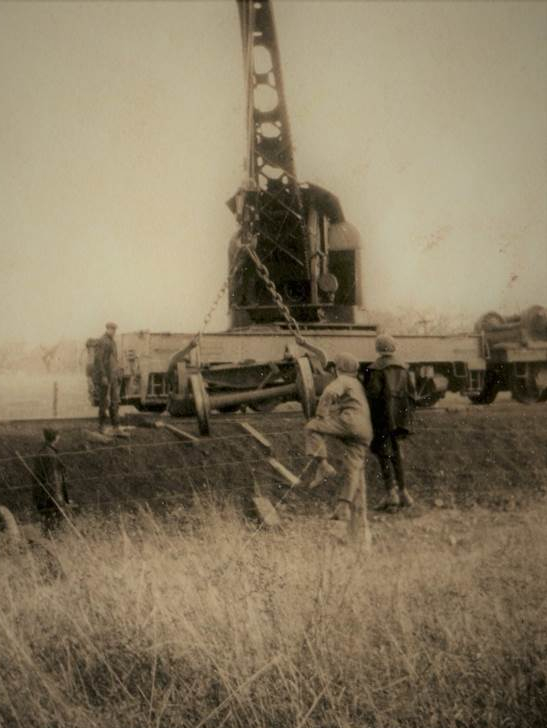Traveling by rail in 19th century was often a very frightening endeavor. In the early part of the century up until 1850, catastrophic accidents with loss of life were not all that common. However, as more track was laid and the speed of trains increased, the accident rate increased exponentially. According to government statistics, in 1890 there were 7,029 railroad related fatalities along with 33, 881 people injured! The peak year, 1907, counted 11,839 fatalities and 111,016 injured. After 1907, the numbers slowly came down. By 1957 the number was reduced to 2,393 which was a huge improvement, but still a huge number by modern safety standards. Unfortunately, The RW&O Railroad also known as the “Hojack” line which began service in 1876 was not immune from suffering its share of deadly disasters as well as a handful of other colorful incidents. In this this article some of these stories, some long forgotten, will be retold because they remain a part of Wilson’s local history.
On July 27th, 1883 The “Steamboat Express” was traveling east on the RW&O with a load of passengers headed to the Thousand Islands when disaster struck just past the Carlyon Station in Orleans County. The train had departed Lewiston Station 20 minutes behind schedule and Lyndonville Station 30 minutes behind schedule. This may have been due to severe summer thunderstorms in the area that night. Despite the weather, the train was cruising at its normal speed which was about 25 miles an hour. At approximately 9:48 pm the fireman opened the furnace door to feed the boiler. This temporarily blinded the engineer. When he regained his sight, he saw a stationary freight car just ahead blocking the way. The engineer slammed on the brakes and reversed the engine, but the freight car was much too close. The engine hit the freight car with almost a full head of steam. The engine rolled on its side while the heavier sleeper cars at the rear of the train pressed the lighter passenger cars into the engine smashing them to pieces and pinning passengers in the wreckage. By the time it was over, 17 people died in the wreck. They were laid out on the station platform for identification.
After the disaster, the station agent on duty, W.A. Barry, was questioned by investigators who wanted to know what the freight car was doing on the main track. It was Barry’s responsibility to ensure the car was moved to an adjacent siding. Barry claimed that he had in fact moved the car off the track and set the brake. The track watcher that evening, Albert Perry, seemed to back Barry’s claim stating that 30 minutes prior to the train coming through the track was clear. The accident investigation never was able to come to a clear resolution of what actually happened and who was responsible. Barry, the station agent, suggested a group of malicious persons pushed the freight car onto the track.
The wreck was written about and discussed for years afterward. Numerous civil suits were filed against the RW&O for the incident by family members of the victims. One of the more morbid stories to be told about that evening was that personal belongings and money were stripped from the deceased. The Carylon railroad station (not to be confused with Carlton) was located on the Yates-Carlton Townline Road between Ashwood and Alps Roads. The hamlet’s name was later changed to Ashwood.
A few years later on August 10th 1889, another bad accident occurred. An east bound night express train travelling on the RW & O line going to Niagara Falls collided with a stopped train near Webster New York at 8 am in the morning. The stopped train was rear-ended and four cars telescoped into one another. Two people died and eight others were badly injured. The accident resulted in the railroad installing automotive style brakes on passenger trains. These are just two examples of bad accidents on the RW & O line. There were many others too numerous to mention. These two occurred relatively close to Wilson. For this reason I thought it worth mentioning. Closer to Wilson itself, a few incidents and tragedies also occurred although not as horrific as the aforementioned.
The March 25, 1885 edition of The Lockport Daily Journal reported that a freight train derailment occurred the previous evening near Wilson. “It jumped the track a few rods west of Wilson Station, owing to a broken rail. Four freight cars left the track and ended up in the ditch on the south side, smashing the cars and tearing up the tracks. From two to three rods of rails were torn up.” There were no reported injuries. There was a saying that RW&O stood for “Rotten wood and old rusty nails.” Because of the sheer number of accidents on the line, it would be hard to refute the acronym.
On March 27th, 1924 a major derailment occurred on a west bound freight train loaded with farm produce about 60 rods (about two tenths of a mile) west of Wilson Station. Ten freight cars in all derailed scattering apples, vinegar, candy merchandise and other goods all over the scene. Unlike many accidents on the RW&O line, this one was attributed to an axle breaking on one of the cars. It was reported the train was travelling at a high rate of speed. Over 100 feet of track and roadbed were badly torn up. Rail traffic from both directions including the mail train was held up for two days while the site was cleared of debris. A west bound train with a large amount of milk scheduled for delivery to Niagara Falls was backed up to its origination point in Rochester where the milk was transferred on to trucks for delivery. For as bad as the accident was, it was fortunate that no one was killed or injured.
In addition to railroad accidents, another type of problem became more frequent in the 1920s. Freight car robberies had become an epidemic on the Buffalo and Western New York section of The New York Central line. It was so out of control that Chief J.D. Rooses of the New York Central Police came to Buffalo to direct the work of catching those responsible. One such apprehension occurred in Wilson.
On July 31st 1924, Frank Gartner of Niagara Falls, Ontario was fatally shot by New York Central Railroad police as he attempted to rob a freight car near Wilson Station. It was reported that Gartner lowered himself over the side of the freight car using a rope ladder. Unfortunately for Gartner, detectives had been tipped off and were waiting for him as he entered the box car. Gartner was shot in the abdomen and later died. Apparently Gartner was part of a larger burglary ring as three other suspects were arrested within days in connection with a series of freight car robberies. The three men arrested were Edward J. Kelley a Niagara Falls fireman, Albert Perry, a former railroad engineer who resided on Lockport Road near Niagara Falls and Thomas Shanahan of Niagara Falls.
Kelley and Perry were arrested sitting in an automobile in Niagara Falls while Shanahan was captured at the Ransomville railroad station. Police found a quantity of the stolen goods on a farm in Allegany County owned by Perry. The Daily News of Batavia reported that the stolen goods amounted to $100,000. This may have been a typo, as a report from a Buffalo paper listed the amount to be $10,000. In any event, it demonstrates that dangerous acrobatic high stakes train robberies were not just the stuff of movies. It happened right here in Wilson.
For those who worked on the railroads as engineers and brakeman during this era the potential for dangerous and deadly accidents was something that was faced every day. In January of 1931, Sixty year old RW&O brakeman, William S. March was crushed to death between two freight cars as they were being switched at Wilson Station. Apparently, Marsh slipped while breaking a connection. He died almost immediately.
Although derailment accidents on the RW&O were much more common in the 19th and early 20th centuries, there were relatively recent mishaps right up until the line ceased operations in 1979. On January 10, 1969, a Penn Central locomotive and three tanker cars filled with liquid chlorine derailed at the Palmer Road crossing. No one was injured and the rail cars were removed from the crossing within hours. Apparently not a lot of investigating took place as to what caused the derailment, as railway officials planned to place the cars and locomotive back on the tracks two days later!
As you have read these accounts of accidents and incidents, you may have wondered if the RW& O was significantly more dangerous than other railroads during its history. The answer would be not really. As mentioned at the beginning, railroads were notoriously dangerous in the late 18th century. This was a time when regulations and protections for consumers were nonexistent. Given their safety record, it’s a wonder that people traveled by rail at all. It was a case of the curiosity and speed of travel overcoming the fear of what could happen. Imagine if today’s airline industry had the record that railroads once had. Would anyone get on an airplane? It was also a case of technology outpacing safety. Locomotives were able to travel faster, but in most cases they traveled faster over old poorly constructed road beds and rails. Better brakes, switching technology and other safety practices were still being developed. It wouldn’t be until later in the 1930s before the accident and death rate from railroad accidents dropped significantly. The accidents mentioned here are by no means a complete list. There were numerous others that occurred along the RW&O line waiting to be rediscovered by railroad history buffs and local community historians.
Submitted by
Francis Gallagher
Wilson Town Historian

| March 27th, 1924 Derailment just west of Wilson Station Wilson Historical Society |

|
Clearing accident debris at Wilson Station (March 1924) Wilson Historical Society |
Bibliography of Works Consulted
Historical Statistics of the United States, colonial times to 1970, Part 2
By The United States Bureau of the Census
“Question Three Suspects About Series of Thefts.” The Batavia Daily News 2 August. 1924
“Brakeman Crushed to Death by Freight Cars at Wilson.” Buffalo Courier Express 25 January. 1931
“Freight Wreck caused at Wilson When Axle breaks; Rails and Ties Torn Up.” Niagara Falls Gazette 1 April. 1924
“A Bad Railway Wreck.” The New York Times 29 July. 1883
Aldrich, Mark. Death Rode the Rails. Baltimore: Johns Hopkins University Press, 2006